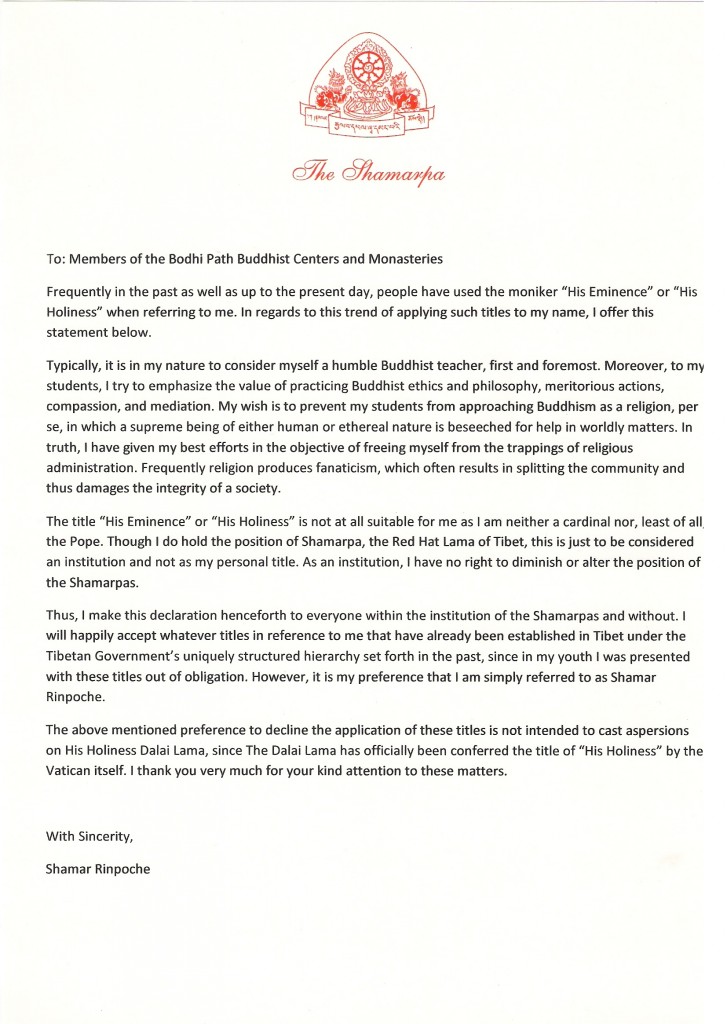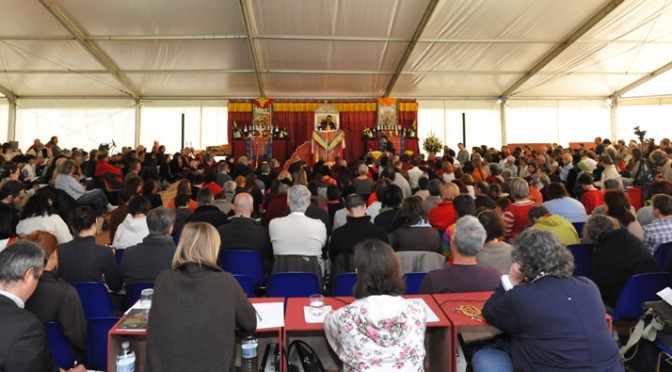Trungpa Rinpoché sent me this eight-point prediction letter in 1973. He wrote it in his own hand, as he was young and able at that time. Rinpoché asked his personal deity for a pramana prediction concerning my activity. During the rituals called létsok, or activity practices, a deity is invoked – a yidam or Dharma protector – and highly accomplished practitioners can ask them questions. Their answers appear in a mirror. Trungpa Rinpoché’s deity for this practice was the deity Lhamo Youdrönma, Goddess of the Turquoise Lamp. Rinpoché copied her answers from the mirror and sent them to me via Aché Tséphel, the secretary of the 16th Karmapa. I still have this letter.
– Shamar Rinpoché, June 2010
Chögyam Trungpa Rinpoché’s original letter
Word by word translation with Tibetan
Concerning Kyabjé Shamar Rinpoché’s life prediction:
Dzaya Ho!
Everlasting, indestructible Vajra Spring: the profound, clear symbolic wording is shown by Youdrönma, Turquoise Lamp, unconstrained and unhurried.
Always keep the life deity of emerald radiance in your innermost heart.
The light of the evil youth’s messenger will be burnt by the fire of the end of time.
Please do the ritual of the Wrathful Guru!
The darkness of the era can be consumed by the fire of the ruby-colored crown.
The ring of five times ten (age) should be inserted into the mantra of indestructible life.
Accomplish Vajrakilaya which overcomes black magic and vigorously purify through the practice of Mamaki!
Beware of those intoxicated and maddened elephants who would stir up internal conflicts.
There is the possibility that the prosperous yellow intellectualists will damage the lineage of true meaning. Therefore, sharpen the speartip of your wise and prudent mind.
Please do a closed three-year, three-fortnight retreat in the very blessed practice place of the holy masters, the vajra rock mountain which glitters like gold.
By the white light of Vajrasattva, you will move to the non-meditation level of Dharmakaya.
In your innermost heart, please develop these points.
Samaya!
At the request of the Bodhi Path administrators and several of his oldest disciples, both Tibetans and non-Tibetans, Shamar Rinpoché has agreed to present this precious prediction letter. He asked me to work on the translation and guided me through the wording. Below are some of the additional explanations he gave for the sake of clarification. The original letter is attached in .pdf format for reference.
– Pamela Gayle White, translator, June 2010
In the first three lines, Lhamo Youdrönma, Goddess of the Turquoise Lamp, says: I will give profound and clear instructions about your present and future activity. Her words indicate that Shamar Rinpoché should do the practice of the emerald-colored deity, Green Tara. Rinpoché explains that this was really quite wonderful, because at the time he was in fact writing a Green Tara practice sadhana which many lamas are now using. Trungpa Rinpoché couldn’t possibly have known this – they had met briefly when Shamarpa was young but had no personal contact at that time of the prediction. In 1973 the rinpochés who lived on different continents had to communicate by sending letters through the post – it seems that even exchanging Happy New Years cards was a challenge.
The next three verses indicate that Shamar Rinpoché, who was 23, was in a phase in his life where he might be distracted by his youthful energy. He explains that he needed the light of a very strong remedy that could outshine the youthful light of romance, as these distractions could potentially disrupt his beneficial activity. The powerful light that could burn through obstacles was Guru Drakpo, the practice of a wrathful aspect of Padmasambhava.
Shamar Rinpoché says that a year or so after receiving this letter, he went to Dharamsala with the 16th Karmapa, as there were official meetings with the Dalaï Lama and the government-in-exile there. He was very ill with food poisoning contracted in the Punjabi city of Ludhiana, so he stayed behind and was sleeping alone in the Dalai Lama’s guest house. Suddenly, there appeared at the door an extremely powerful-looking monk in a yellow cap who seemed intent on harming Rinpoché. Rinpoché thought he must be the deity Shukden; he explains that at the time there was general concern about problems related to certain practices of the Gelug sect. He immediately invoked Guru Padmasambhava. “I tried to imagine myself in his form,” Rinpoché says, “thinking that I needed to develop lovingkindness and compassion as Padmasambhava had in order to get rid of this demon. I concentrated very hard, then looked up and saw that he had disappeared – now I only saw the door shutter. Up until this time, I had not been so aware of Guru Rinpoché – of course, I did not doubt the power of his practice, but it had not been a focus of mine. After that, I did the practice much more seriously.”
The next verse refers to the ruby crown which, according to Tibetan history, refers to the Shamarpas – ‘sha’ means hat or crown; ‘mar’ means red. It states that it would be possible for the Shamarpa to eliminate the darkness of an era, but the time is not indicated. Since the 14th Shamar Rinpoché carries the Shamarpa title, because of his past karma he may be connected to one of the Shamarpas who made such a wish, and great benefit might spontaneously occur through his activity. In the divination, Youdrönma doesn’t say: Shamar Rinpoché should do this; rather, she is saying that beneficial activity may naturally happen based on past wishes.
As for the next verse, Rinpoché believes it refers to being 49 years old – Tibetans consider this to be an age where life-endangering obstacles are more likely to arise than most other years. Because Lhamo Youdrön specifically said that at fifty he should do this specific practice, Shamarpa went with Sangzang Rinpoché by helicopter to the Marathika cave in Nepal where Trulshik Rinpoché was practicing at the time. There they received the Chimé Phagma White Tara long life empowerments from him in very auspicious circumstances, as this was the cave where Guru Rinpoché accomplished his own long life practice.
As for the Vajrakilaya and Mamaki practices she mentioned, Rinpoché explains that he has already done them.
Concerning the verses that begin with the mad elephant, it seems that these directly refer to the ongoing Karma Kagyu controversies. Rinpoché says, “I can now say that I did not follow Youdrönma’s explanations carefully enough. I did not know who to be careful about and many mistakes were made – collaboration and betrayal took place but I did not expect them. I was wary of outsiders, yes, but not of insiders, and the mad, intoxicated elephants turned out to be people I never would have suspected – people from inside our organization who collaborated with outsiders.”
This controversy is well documented in works such as the Karmapa Papers; The Buddha Cries! Karmapa Conundrum by Anil Maheshwari of the Hindustani Times; Buddha’s Not Smiling by Eric Curren; and the Karmapa Prophesies by Sylvia Wong – there is no need to explain these topics again here. The books of Lea Terhune, Mick Brown and Michelle Martin tell the other angle of the story. Rinpoché says that there is no ‘religious’ pressure to take sides; readers are free to inform themselves and make their own conclusions about where the truth lies.
The rest of the divination verse refers to Shamarpa’s meditation practice. It says that he should do certain practices according to connections from past lives. The end of the divination infers that a very high level of meditation can be achieved in this lifetime.

